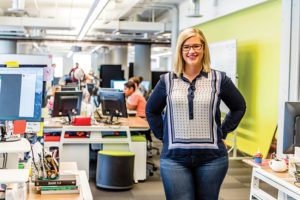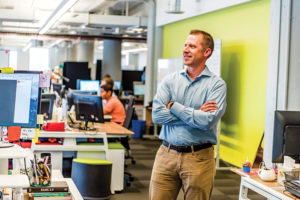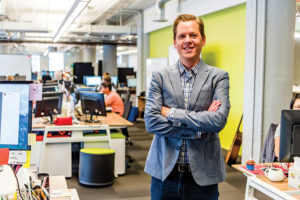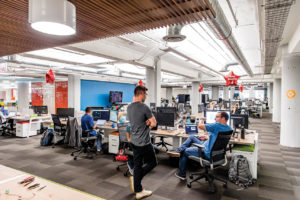An inside look at an Alumnus’ lead digital-product development firm
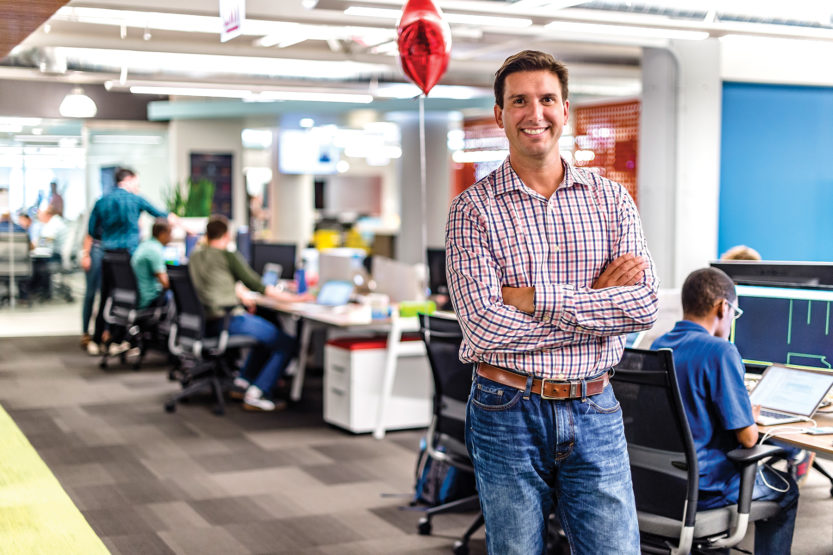 Photography By Scott Thompson
Photography By Scott Thompson If you’ve ever managed your Discover card by mobile phone, you can thank Solstice. If you’ve ever rented a movie from Redbox using your smartphone, that’s Solstice, too.
Solstice is an international company. It has offices in Chicago’s tech-friendly West Loop, New York City, London and Buenos Aires, Argentina. Since its founding in 2001, it has worked with the likes of Kraft Foods to create a virtual workplace that better connects the company’s widely dispersed employees.
Clients as diverse as Bosch, First Alert and McDonald’s have hired Solstice to develop software solutions for their emerging e-commerce markets. Solstice develops digital products for the customers and employees of more than 100 Fortune 1000 companies.
“In the simplest terms, we’re a digital-product development firm,” says Solstice founder and Chief Executive Officer J Schwan, ’97 ENG. “Some of our clients have described working with us like having an elite startup in their back pocket.”
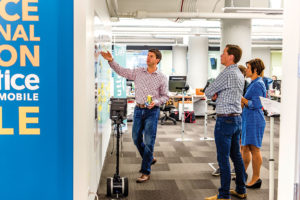
Three members of Solstice’s six-person
leadership team are Illini. More than 10 percent of its 260 employees have degrees from Illinois.
Schwan grew up in Chicago’s western suburbs and attended Illinois as an undergraduate. He was intent on becoming a materials science engineer. Those were the early days of the internet’s transition from a communication link for research universities to an information superhighway, a transformation largely enabled by the University’s National Center for Supercomputing Applications.
“Illinois was advanced in terms of getting students early access to internet and web technologies,” Schwan says. “I would do my coursework during the day, and a bunch of buddies and I would geek out on this internet stuff at night.”
This dichotomy between coursework and the internet became a defining part of Schwan’s development. He had taken a work-study job in the materials research lab of Jennifer Lewis, then-UI Hans Thurnauer Professor of Materials Science and Engineering. “I really didn’t know what I was doing,” Schwan confesses, “but I liked working on the team and with Professor Lewis. She called me into her office after six months and said, ‘J, I don’t think you should be a materials scientist.’
“I was devastated,” Schwan recalls, but Lewis didn’t leave him hanging. “She said to me, ‘I can tell you’re a smart guy, and I can tell that you’re really good with people. What kind of things do you enjoy doing?’ ” Schwan owned up to his internet obsession and that he was teaching himself to program. Lewis, in turn, introduced him to a UI faculty member who needed help putting materials-science curricula on the web. And with that, Schwan found himself.
Right after graduation, he began doing web development for Andersen Consulting/Accenture. At the start of the millennium, he founded Solstice.
Empowered People
Solstice strives to create emotional connections that focus on human context. Robin (Sellers) Monical, ’09 LAS, Solstice’s talent acquisition team leader, was born and raised in Peoria and attended Illinois to major in Spanish. Her first job after graduation was working in employee placement for a third-party staffing company that had Solstice as a client. She liked what she saw at Solstice. “The office culture was much more corporate in my previous organization, with a much more traditional, top-down management style,” she says. “Solstice works hard to empower people rather than put top-down management into place.”
Customer and employee relations at Solstice are informed by an exceptionally humanistic principle: servant leadership. Schwan is equally passionate about empowering Solstice’s clients. “After working with us, our clients often realize our development process is helpful to their business—and not just because you can build this cool thing. They can borrow some of how we work and incorporate it into their organization. We’ve seen our most strategic partners change how they operate after working with us.”
A quick scan of employee resumes at Solstice shows majors run the gamut from comp lit to accounting to Spanish alongside the expected computer science and engineering. The company’s workspace is bright and open, strategically designed to enhance communication, collaboration and creativity and downplay any sense of corporate hierarchy. (See sidebar.)
“We hire a lot more at the junior level and promote within on a quarterly basis,” Monical says. “Our people grow really organically, thanks in part to an annual $5,000-per-employee training budget.”
The company bases its operating model on the Silicon Valley-endorsed principles of scrum methodology. Fluid, cross-functional teams come together on a project basis. Each project “scrum” consists of eight members: scrum master (who doesn’t manage the team, but works to target goals and remove obstacles), strategist, researcher, designer, developer, programmer, quality assurance expert and tester.
Chief Financial Officer Dan Kardatzke, ’96 BUS, notes that the company’s environment plays a key role in Solstice’s success. “J has built probably the best culture I’ll ever work for. It’s one of the reasons we don’t lose a lot of our people. We work on great ideas with great companies that actually deploy our technologies. You can show your friends: ‘Hey! I built this!’”
Workplace Robots
Solstice Labs, the company’s research and development team, has developed Tutler, an autonomous robot that uses Google’s Project Tango 3-D motion and depth-sensing technology to react to ever-changing environs. The company hopes to develop its “Tango butler” to become its tech ambassador. Tutler will conduct tours of the office, lead guests to appointments and deliver office supplies and cold drinks on request.
“Cold drinks” at Solstice brings us to Vender, a soda machine with personality that has been re-engineered so that employees can interact with it through their laptops and phones, via voice recognition devices such as Amazon’s Alexa, and even through such devices as Oculus Rift and Google Cardboard. Vender knows when it’s nearly out of a particular product and can automatically reorder. It knows who purchases how much of what and when.
Fostering an Upstart Startup
Research and development allows the company to keep its eye on what’s next. It’s the essence of the “upstart startup” attitude that Solstice brings to its clients. “Most companies are thinking in the context of the now,” says Schwan, “and we have customers who come to us with a lot of ‘now’ problems. What we task ourselves with are the near and the next—helping companies understand today’s technologies and use them in new ways in the near term. From there, we move to the next set of technologies that we think are coming in the next two or three years. We do a lot of internal R&D on those.”
“How hard can it be?” asks Paul Heckel, ’00 LAS, Solstice’s director of digital strategy. He’s referring to the company’s mantra about the art of “design-gineering”—using creativity to solve real-world technical problems. “Of course, things can get difficult,” he says. “There is navigating very complicated organizations. There’s technical problems to solve, all of that. But bringing a ‘can-do, how-hard-can-it-really-be?’ attitude to a project unlocks doors to new possibilities.
“We have a specific yet fluid process for marrying the tactical requests our clients come to us with and the inspiration we know is possible,” says Heckel. “That’s the centerpiece of our innovation sessions. We’ll have one- or two-day facilitated sessions where we set context about why we’re there. Then we’ll diverge from that into a universe of possibilities that may or may not exist today. From there, we go through a set of activities to converge back onto what’s possible. We go broad and then go back narrow, but never lose sight of what we were asked to do. We offer inspiration and insight into things people didn’t know were possible.”
Heckel’s journey to a new millennium has a surprisingly old-school origin. Thanks to his father—an AT&T engineer—he grew up with a computer in the house, but found his first passion in high school as a newspaper editor. When he learned, as a journalism major at UI that he would have to start out in Reporting 101, he opted for something more challenging: comparative literature. He next completed a master’s degree in technology management and hasn’t looked back.
Open Concept
Work environment stresses collaboration and exchange of ideas.
Walk into Solstice and look up. Marquee lights spell out “Awesome.” The open expanse of the West Loop office is dotted with work spaces arranged in configurations of eight—the number of team members in a Solstice project-work “scrum.” Everything is on wheels, which suggests that when you come in tomorrow, the lay of the land may have changed.
There are few opaque internal walls, and the ones that do define spaces are covered with white boards, sticky notes and word clouds. Meeting and conference rooms are named after great thinkers and innovators. They’re open and outfitted with comfortable furniture. You’d be hard-pressed to find a sports jacket here. And no way on neckties.
Solstice CEO J Schwan acknowledges that there is an element of Silicon Valley chic here, but that comes from form following function. “Everything is open,” he says. “Information, collaboration and that kind of support are freely exchanged. That’s why every filing cabinet has a cushion on it so people can sit down and help the person next to them. Things were thought through, so we have a physical representation of what we believe. It’s all very organic to our processes.” It also may reflect the aesthetic choices of a new work generation; the median age of the Solstice team is 30.
“Our clients enjoy coming into this space because it brings them to a different place intellectually and maybe a different place from their corporate environment,” says the leader of Solstice’s talent acquisition team, Robin Monical. “They’re used to sitting in an office or a cube. Coming here gets different processes flowing and sets a different tone for conversation.” — D.S.
Home Field Advantage
The consensus at Solstice is that the company’s Chicago home base sets it apart from competition in San Francisco and Boston. Founder J Schwan is proud of his University of Illinois roots. Three members of the company’s six-person leadership team are Illini. More than 10 percent of its 260 employees have degrees from Illinois.
“We recruit heavily from Illinois,” says Monical. “There are lots of great engineering schools, but we think it’s a distinct advantage for us to maintain meaningful ties to UI professors and their work.” She notes that Solstice works hard to maintain a presence on the UI campus. “We go to the [school’s] career fairs twice a year. This year, we’re one of the sponsors for the campus hackathon.” (Hackathons have become popular at many tech campuses. Students hold code-writing marathons in conjunction with tech firms, often in service to local charities and not-for-profits.)
Kardatzke notes that Chicago’s tech sector has grown significantly in the past decade, thanks to concentrated tech incubator efforts such as 1871, Catapult Chicago and the Illinois Technology Association. “Most of our clients are here in the Midwest,” he says. “It’s not like we’re going out to the Coasts and trying to compete. Midwestern companies like to do business with other Midwestern companies.”
Boom to Bust and Back
Kardatzke met Schwan when they were Alpha Delta Phi pledge class brothers. Kardatzke focused on corporate finance in his business studies, and after graduation worked for a Chicago marketing firm where he learned about acquisitions and financial analysis.
The post-9/11 crash hit marketing hard. Consequently, Kardatzke decided to look into other opportunities. Initial public offerings were the rage. He joined forces with his brother Jeff Kardatzke, ’97 eng, who had trained as an electrical engineer at Illinois and developed some of the earliest DVR software. The brothers found what Dan calls a “semi-success” with their venture, Sage TV, which they eventually sold to Google as the operating system for Google Fiber.
Then came the 2008 recession. “In 2010, we had to file for Chapter 11,” Dan Kardatzke says. “At that point, I decided I was going to learn from this and go through the bankruptcy process. I had to testify in U.S. bankruptcy court. We had multiple bidders and ultimately a private equity firm in Phoenix bought us. Six months after we came out of bankruptcy, I called up J. and said, ‘I really want to go to lunch. I have to get some stuff off my chest and vent to you about my work life right now.’ ”
The two soon realized that Kardatzke’s “boom-to-bust-and-back-again” journey was exactly what Solstice needed as it prepared to “go big.” Dan started consulting for his fraternity brother J and joined Solstice in 2013 as CFO.
They investigated bringing in outside investors, but in the end sold Solstice to U.K.–based St. Ives plc, an international collection of companies that describes itself as “offering the best in digital and mobile creativity, intelligent data analysis, research, production and more, at the leading edge of marketing and print services.” What was St. Ives’ appeal? “We gained this overarching parent who’s supportive and can give us what we need to realize our own future,” Schwan says. “It’s been a great accelerant for us.”
The Hollywood ending to a tech story is that the founder sells the company—and sells out its employees—and cashes out big in the end. Not so for Solstice. “Selling the company was about protecting what we had built by finding the right buyer who would continue to let us run it,” Kardatzke says.
Keeping Pace
With the excited hum that permeates the open work space and the cool drinks delivered by Tutler, it’s easy to think Solstice is on a fast track to the future. Is there any way to keep pace with the technical revolution?
“You’ll never be able to catch up,” says strategist Heckel. His knowing smile attests to his training at the U of I as a comp lit major and his years of experience in the tech sector. He knows the race isn’t about robots. It’s about managing and meeting human needs and expectations. “Any digital technology we create—if it’s a robot, virtual reality, whatever—none of it means anything unless there’s a human being at the end,” he says. “You create the greatest algorithm in the world, but at the end of the day, if it’s not usable and it’s not helping somebody improve their life, what good is it?”
“Nothing we do is in yesterday’s world,” adds Schwan.

